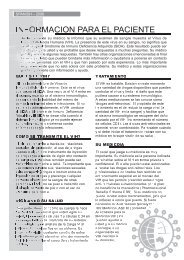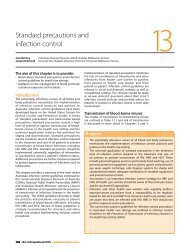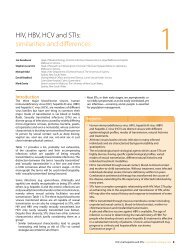B Positive – all you wanted to know about - ASHM
B Positive – all you wanted to know about - ASHM
B Positive – all you wanted to know about - ASHM
You also want an ePaper? Increase the reach of your titles
YUMPU automatically turns print PDFs into web optimized ePapers that Google loves.
interferon-alfa, as a non-nucleoside-based<br />
therapy, can be considered for patients in this<br />
context, provided they have adequate hepatic<br />
reserve, although its efficacy is reduced in the<br />
context of HiV infection, particularly with more<br />
advanced immunodeficiency. 11<br />
another reason <strong>to</strong> incorporate HbV active<br />
agents in a Haart regimen is <strong>to</strong> avert<br />
immune reconstitution hepatitis. the<br />
immune reconstitution inflamma<strong>to</strong>ry<br />
syndrome describes a pathology deriving<br />
from resurgent immune attacks on chronic<br />
infections in patients with HiV, following the<br />
commencement of Haart. HbV flares in the<br />
setting of immune reconstitution are more<br />
common in patients with a high baseline HbV<br />
viral load 11 , and can result in significant liver<br />
disease and mortality, particularly in patients<br />
with advanced liver disease and poor hepatic<br />
reserve. However, flares can also lead <strong>to</strong><br />
Hbeag clearance and the suppression of viral<br />
replication in some patients. 9 caution when<br />
changing Haart regimens in co-infected<br />
patients is also necessary, as ceasing HbV-active<br />
agents can cause reactivation. continuation of<br />
these antivirals should be considered even if<br />
they add little <strong>to</strong> the patient’s HiV therapy.<br />
HBV/HCV co-infection<br />
in contrast <strong>to</strong> the co-infection with HiV, it is<br />
common for patients with HcV co-infection<br />
<strong>to</strong> have a reduced replication of HbV, with<br />
lower viral loads than in patients with HbV<br />
monoinfection. this is because HcV directly<br />
interferes with the HbV replication. it is a<br />
common finding in HbV/HcV co-infection that<br />
one of the viruses predominates in terms of viral<br />
replication, with the suppression of the other<br />
virus. 9 as with HiV, occult (Hbsag-negative)<br />
HbV infection is also seen more commonly in<br />
patients with HcV co-infection.<br />
acute co-infection (usu<strong>all</strong>y arising through<br />
injecting drug use) has been associated with<br />
an increased incidence of fulminant hepatitis.<br />
chronic HbV/HcV co-infection is usu<strong>all</strong>y<br />
associated with a more severe liver disease, an<br />
increased risk of progression <strong>to</strong> cirrhosis and<br />
a higher incidence of Hcc. a recent australian<br />
study showed that co-infection with HbV and<br />
HcV was associated with much higher mortality<br />
rates (liver-related and <strong>all</strong> cause) than infection<br />
with either HbV or HcV alone; patients with<br />
co-infection had mortality rates approximately<br />
three times higher than patients with HbV<br />
infection only. 13<br />
in patients with chronic HbV/HcV co-infection<br />
meeting the criteria for therapy for either<br />
infection, consideration should be given <strong>to</strong><br />
combination therapy with pegylated interferonalfa<br />
plus ribavirin, even if the HbV infection<br />
predominates. reactivation of previously<br />
suppressed HbV replication following treatment<br />
of HcV with standard interferon plus ribavirin<br />
has been reported, leading <strong>to</strong> suggestions that<br />
combination with additional anti-HbV agents<br />
should be considered. this approach is not<br />
univers<strong>all</strong>y followed.<br />
HBV/HDV co-infection<br />
in non-endemic countries such as australia,<br />
HdV infection is most commonly associated<br />
with injecting drug use (idu). HdV is a defective<br />
virus that requires co-infection with HbV <strong>to</strong><br />
synthesise new virions. similar <strong>to</strong> the situation<br />
of HbV/HcV co-infection, HdV infection results<br />
in the suppression of HbV replication with<br />
sometimes low or even undetectable Hbsag<br />
levels.<br />
acute co-infection with HbV/HdV is typic<strong>all</strong>y<br />
indistinguishable from HbV monoinfection, but<br />
has been associated with a higher incidence<br />
of fulminant hepatitis. the rate of progression<br />
<strong>to</strong> chronicity is no different from that for HbV<br />
infection alone. HdV superinfection of a patient<br />
with existing chronic HbV can present as an<br />
acute hepatitis flare, and progression <strong>to</strong> chronic<br />
HdV infection is almost universal. chronic HbV/<br />
HdV co-infection has been associated with a<br />
more severe liver disease and the increased<br />
incidence of Hcc and mortality. treatment of<br />
HbV/HdV co-infection is with interferon-alfa,<br />
conventional or pegylated, for a period of<br />
one year 7 , although treatment eradicates the<br />
virus in only a minority of patients and relapse<br />
following therapy is common. Lamivudine is<br />
ineffective against HdV and the addition of<br />
ribavirin <strong>to</strong> interferon also confers no benefit.<br />
b <strong>Positive</strong> <strong>–</strong> <strong>all</strong> <strong>you</strong> <strong>wanted</strong> <strong>to</strong> <strong>know</strong> <strong>about</strong> hepatitis b: a guide for primary care providers 79






